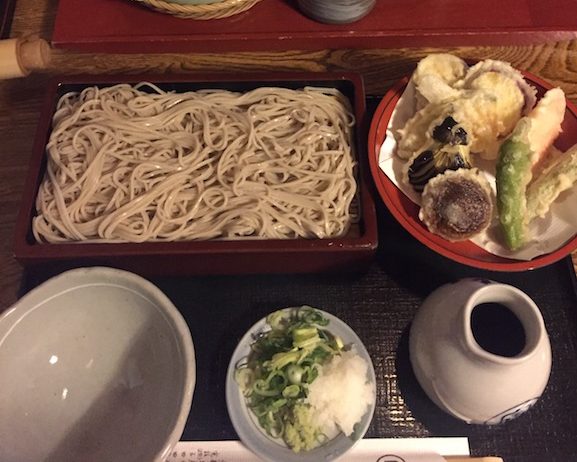The next few days were fun, I went out with some of my friends, visited the bookstore, and did a little bit of shopping. My youngest host sister also had a lot of free time, so we talked and played the Game of Life together. It was fun. On Dec. 30th, the entire family packed up our things and went to Matsushima, where my host father’s parents live. As most people living in Miyagi prefecture will tell you, Matsushima is considered the third most beautiful place in all Japan. The people of Miyagi are quite proud of that, so I’ve been informed three or four times. It truly is beautiful. Sitting right on the ocean, it reminds me of my hometown in America. Both Matsushima and Duxbury are relatively small, scenic, tourist towns, with beautiful beaches. Matsushima is more urban than Duxbury though.
Before leaving, my host father set up a sanbo (small shrine) on the counter that separates the kitchen from the dining/living room. It was very simple, made of wood. It was basically a hexagonal cylinder with a few round holes in the sides. On top of the shrine he placed a plastic dome containing mochi (rice cakes). Originally the dome itself would have been made of mochi, but houses are warmer in modern times, so the mochi would go bad too quickly. The mochi isn’t eaten until the tenth of January, so it has to keep well. On top of that he placed a plastic clementine, with a pretty fan on top (these came with the mochi). A beautiful piece of fabric, and a picture lay under all of this. The picture was placed in such a way that it hung down from the counter and was visible. He also placed salt next to the door facing north. This is called morijio. The jio is from shio (salt), and the mori is from sankaku o moru (I think this means filling the triangle). We also placed redoushi throughout the house. They are circular wreaths made out of some kind of plant material (I’m sorry, I don’t know what it is, but it looks like straw. ) with three long ends of the same plant material hanging down.
On arriving at Matsushima, the first thing we did was clean the house thoroughly. We had also cleaned the house in Sendai before we left. It is important that the house be clean as it enters the new year. After that, we did the same things we had done in Sendai; read, watched TV, studied. Because my host father’s parents run a store, we also spent some time helping out. My youngest sister especially enjoys helping clear tables and wash dishes for the customers.
The next day was New Year’s Eve. The Japanese call it Oomisoka. Unlike in America, the real celebration is not New Year’s Eve, but the days after. On Oomisoka, we got to experience an interesting tradition found only in Mastushima. In ancient times, when there was a fire, an obousan (Buddhist priest or monk) from Korea came and rang a bell. The fire stopped. Because of that, in Matsushima, every year on New Year’s Eve, an obousan and a tsukibito (I don’t know what this means literally, but it refers to the person who rings the bell. ) go from house to house, chanting and ringing a bell. This is to protect the houses from fire in the next year.
We all went downstairs to the shop part of the building and waited. My host father set up some incense, hot sugar water and a candle on a table, which he brought to the front door. We waited, and after a time, heard the bell and chanting. We watched the tsukibito ringing the bell and the obousan chanting at the shop across the street. My host father lit the candle. When they came to us, we all stood in the shadows, and covered our eyes. (I asked why you do this, and my host mother said ‘because you can’t see God’.) The chanting and bell ringing seemed to go on forever. Finally it faded away and we opened our eyes. Everyone drank some of the sugar water to ward off colds in the next year, and we all went back up to the apartment part of the building.
Later we all ate soba (because soba noodles are long, they are eaten in order to have long life.). The adults went to bed, while to kids stayed up until midnight. To my surprise, the next morning everyone got up early. As I later learned, this is to see hatsuhinode (the first rising of the sun) which is considered a good thing. Everyone took pictures of it, including me. Maybe this is because my house in America is surrounded by trees, but it seems like every sunrise and sunset in Japan is spectacular, and this was especially so in Matsushima. I could certainly understand why it is considered one of the most beautiful places in Japan. Breakfast was also special ganjitsu (New Year’s day food). There was anko (Japanese candy made from beans) with mochi in it, and ozoni, which also contained mochi. (Mochi is a traditional Japanese food). Both were very tasty, and everyone asked for extra servings.

The next day, we drove to my host mother’s parents house, where everyone ate lunch, talked to relatives, and generally enjoyed themselves. We also ate norimochi (seaweed mochi), which is mochi wrapped in seaweed. I loved it. After that we went home, and sadly, I had to pack my things up again, as I was switching host families soon.
Leave a Reply